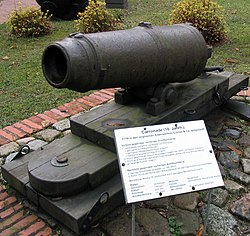This article includes a list of general references, but it lacks sufficient corresponding inline citations. (August 2021) |
| Carronade | |
|---|---|
 | |
| Type | Naval gun |
| Place of origin | United Kingdom |
| Service history | |
| In service | 1778-1881 |
| Used by | British Empire |
| Wars | American Revolutionary War, French Revolutionary Wars, Napoleonic Wars, War of 1812, American Civil War, First Boer War |
| Production history | |
| Designer | Robert Melville |
| Designed | 1778 |
| Manufacturer | Carron Company |
| Specifications | |
| Mass | 12-18 pounders |
| Part of a series on |
| Cannons |
|---|
 |
A carronade is a short, smoothbore, cast-iron cannon which was used by the Royal Navy. It was first produced by the Carron Company, an ironworks in Falkirk, Scotland, and was used from the mid-18th century to the mid-19th century. Its main function was to serve as a powerful, short-range, anti-ship and anti-crew weapon.[1] The technology behind the carronade was greater dimensional precision, with the shot fitting more closely in the barrel, thus transmitting more of the propellant charge's energy to the projectile, allowing a lighter gun using less gunpowder to be effective.
Carronades were initially found to be very successful, but they eventually disappeared as naval artillery advanced, with the introduction of rifling and consequent change in the shape of the projectile, exploding shells replacing solid shot, and naval engagements being fought at longer ranges.
- ^ Keegan, John (1989). The Price of Admiralty. New York: Viking. pp. 276&277. ISBN 0-670-81416-4.